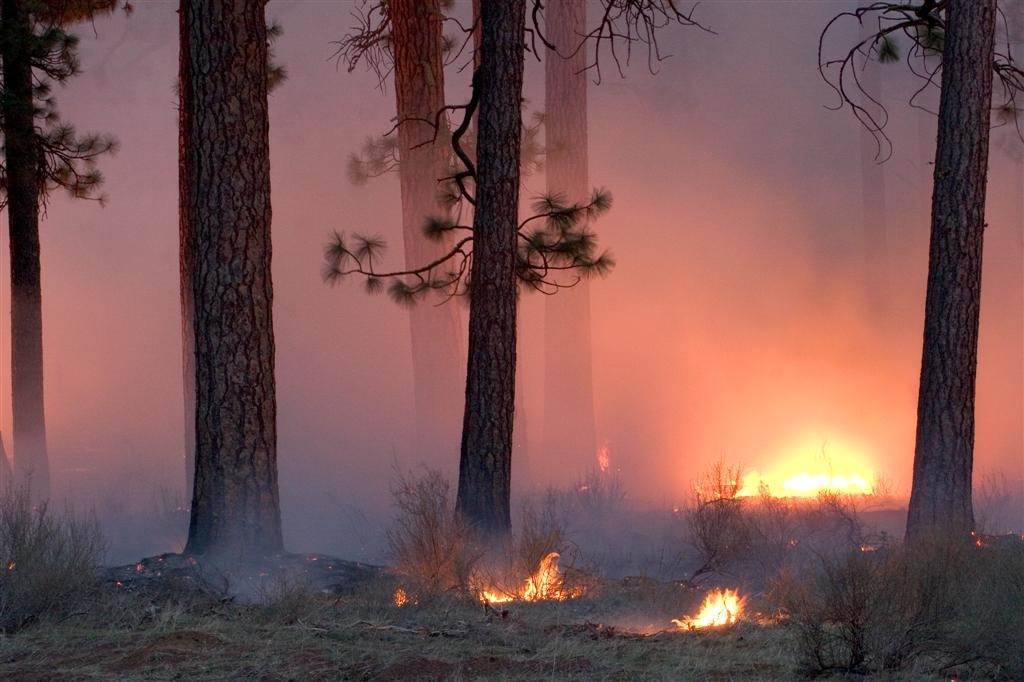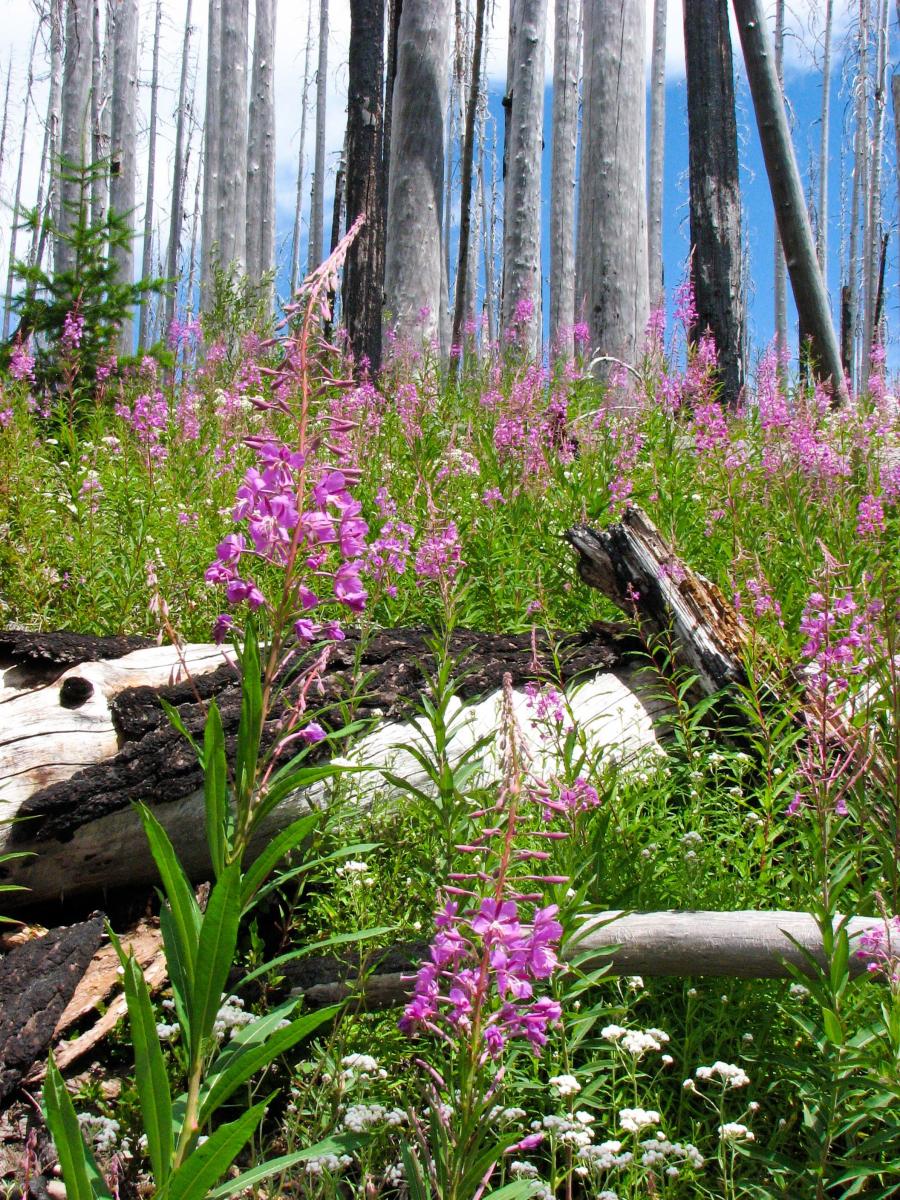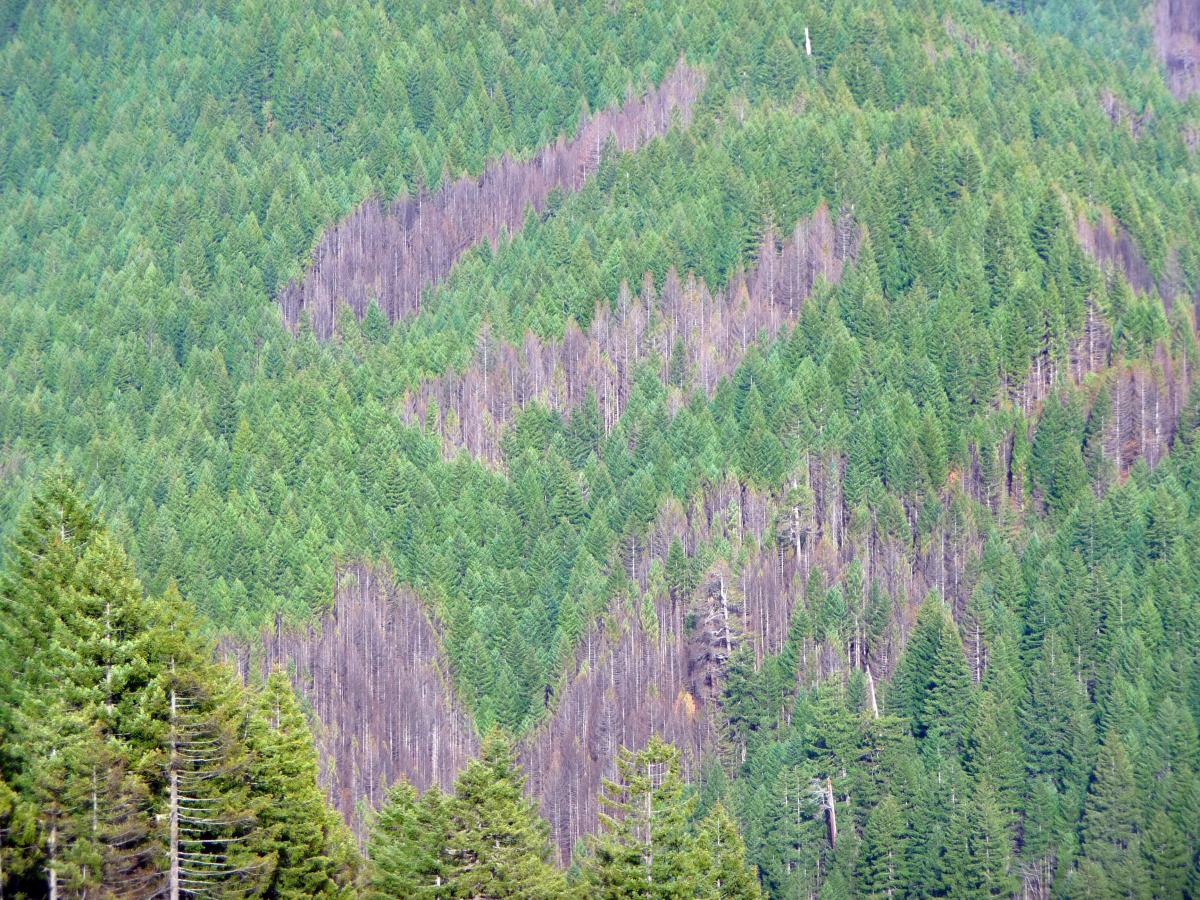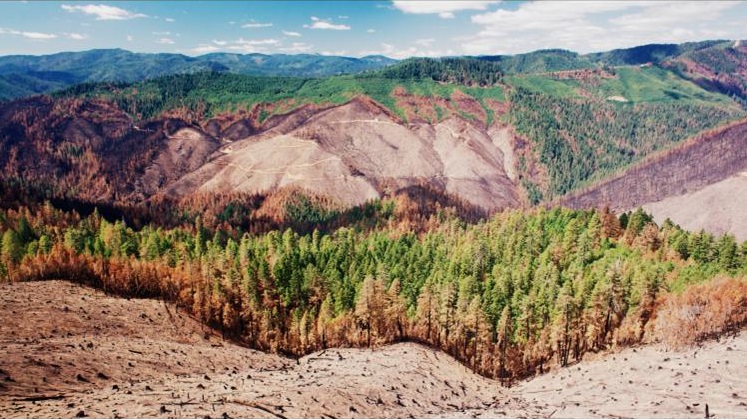|

Forest fires can be a threat to homes and property, but they also play an important role in restoring and maintaining a healthy forest. Here are ten things every Oregonian should know about forest fires in our area.
 Fire is natural and necessary for our forests. By eliminating undergrowth, wildfires create openings in the forest, which enable diverse vegetation growth that provides fruit, seeds, and nectar for wildlife to thrive. Fires also create standing dead trees (snags) that many animals rely on for food and shelter. Forests and wildlife both east and west of the Cascades evolved with fire. Dry Ponderosa pine forests actually need fire to control undergrowth and reduce competition for water and nutrients. However, while fire is often beneficial to forests, unnaturally severe fires—particularly near homes and communities— can be a serious problem.
Fire is natural and necessary for our forests. By eliminating undergrowth, wildfires create openings in the forest, which enable diverse vegetation growth that provides fruit, seeds, and nectar for wildlife to thrive. Fires also create standing dead trees (snags) that many animals rely on for food and shelter. Forests and wildlife both east and west of the Cascades evolved with fire. Dry Ponderosa pine forests actually need fire to control undergrowth and reduce competition for water and nutrients. However, while fire is often beneficial to forests, unnaturally severe fires—particularly near homes and communities— can be a serious problem.
- Humans have changed how fires behave. Native, old-growth forests with complex forest structures are more resilient to wildfire, whereas forests that have been degraded by decades of clearcut logging and replanting are more prone to unnaturally severe fire. One Oregon study found that corporate-owned tree plantations burned at 30% higher severity than adjacent older stands on public lands (Zald & Dunn 2018). By removing the fire-resilient mature and old-growth, planting dense stands of young trees, and suppressing natural fires, logging has created unnaturally flammable conditions in many forests over the last hundred years. Old-growth trees, with their thick bark and tall trunks that keep the forest canopy safely above the flames, are much more fire-resistant than smaller, younger trees with thin bark and dense canopies close to the ground.
- Climate change could increase fire risks. Scientists predict that climate change will bring hotter, drier summers to the Pacific Northwest, together with less snowfall in the mountains during the winter months. Combined, these could significantly increase fire activity. The best way to combat this challenge is to restore and protect more mature and old-growth forests across the landscape while urgently tackling all sources of the climate crisis. Not only are old trees more fire-resistant, but they also capture and store tremendous amounts of carbon dioxide which helps address the climate problem at its root.
 Fires release much less forest carbon than logging. The best available science shows that fires release far less carbon dioxide on an annual basis than logging. Fire occurrence is highly variable. When they do burn, fires often leave vast areas of the forest lightly burned or not burned at all. Even when fires burn hot, the dead trees that are left behind continue to store carbon for decades (as well as anchor the soil and provide shade and nutrients to the next generation of forest). In contrast, short-rotation clearcut logging constantly strips the land of both live and dead trees, depleting the soil and promoting less diverse, more fire-prone conditions. [see more in Forest Defense is Climate Defense]
Fires release much less forest carbon than logging. The best available science shows that fires release far less carbon dioxide on an annual basis than logging. Fire occurrence is highly variable. When they do burn, fires often leave vast areas of the forest lightly burned or not burned at all. Even when fires burn hot, the dead trees that are left behind continue to store carbon for decades (as well as anchor the soil and provide shade and nutrients to the next generation of forest). In contrast, short-rotation clearcut logging constantly strips the land of both live and dead trees, depleting the soil and promoting less diverse, more fire-prone conditions. [see more in Forest Defense is Climate Defense]
- Fire-adapted forests can sometimes benefit from careful restoration. Logging and fire suppression have left some dry forest types unnaturally dense. Restoration-based thinning projects that focus on removing small trees that have grown in due to a lack of natural fires and seek to restore old-growth conditions can be beneficial in these dry forests. Efforts like the Glaze Meadow restoration thinning project near the town of Sisters have reduced fire risks while improving habitat for fish and wildlife. With public education and proper restoration techniques, including thinning and prescribed burning in appropriate places, wildfire could cease to be the terrifying event that many think it is today. Instead, natural fires would be mostly the low-intensity ground fires that renew the forest in the ways it's adapted to. [see more in our Eastside Restoration Handbook]
- Logging forests in the backcountry does not protect homes and communities from wildfire. But it does divert time and money away from projects that actually protect the public. Unfortunately, the Forest Service and other agencies, under pressure from politicians and the logging industry, often have misplaced priorities, and spend millions in federal tax dollars trying to log large trees in remote backcountry areas rather than prioritizing home hardening and fuels reduction in the immediate vicinity of homes and communities. Science is clear that the most effective actions to address community fire hazard are slight design changes to houses themselves and fuel reduction within a few dozen feet of the home.
- Logging after wildfires harms forest recovery. Logging corporations often demand that the Forest Service and other agencies allow “salvage logging” – including in old-growth forests – after forests burn. This controversial practice allows bulldozers and other heavy equipment into fragile recovering areas, where they clear-cut both live and dead trees. Such logging destroys hard-to-replace snags and wildlife habitat, impairs the first plants to emerge after fire, interferes with the development of future healthy forests, damages fragile soil, accelerates transfer of carbon to the atmosphere, and sends mud and sediment into the rivers and streams we rely on for clean drinking water. Scientists have found that letting nature take its course is the best way to help a forest recover after fire.
 Homeowners can prepare for fire. Homeowners who live near forests can reduce risks to their property with a number of simple steps. Keep trees and shrubs pruned away from buildings and structures, use fire-resistant roofing material, screen vents, install double-pane windows, enclose eaves, mow the grass around the home, clean leaves and other debris from roofs and gutters, and move firewood, propane tanks, and other flammable materials at least 50 feet away.
Homeowners can prepare for fire. Homeowners who live near forests can reduce risks to their property with a number of simple steps. Keep trees and shrubs pruned away from buildings and structures, use fire-resistant roofing material, screen vents, install double-pane windows, enclose eaves, mow the grass around the home, clean leaves and other debris from roofs and gutters, and move firewood, propane tanks, and other flammable materials at least 50 feet away.
- Thinning and prescribed fire won’t solve everything. Oregon’s landscapes are incredibly diverse, and those landscapes have evolved differently with fire. For example, Oregon’s Blue Mountains were so-named because they were often obscured by smoke and looked “blue” to early settlers. In some places, Indigenous peoples managed fires to promote the growth of certain foods and habitats. In other places, natural and Indigenous use of fire was rare. One or two ideas are often floated by politicians as blanket policy solutions that apply across the state, whether that be converting forests into tree plantations through “active management”, more money for fire suppression or commercial thinning, or using prescribed fire. These policy pronouncements often go hand-in-hand with efforts to shortcut environmental review and public process. Unfortunately, broadly applying one-size-fits-all policies across a complicated landscape, and rapidly increasing the pace and scale of forest projects across the state can have disastrous consequences, like more severe fire, old-growth logging, species extinctions, rampant fraud, and wasted tax dollars. Our forests are complex systems that have evolved over millennia. We should be humble in our understanding of this complexity and not assume simple, one-size-fits-all solutions are appropriate. Controlling what we can control - where we build, what materials we use, and how we protect those most vulnerable from smoke and other impacts of fire - will always be our best path to safety.
- The logging industry uses fires to advance its agenda. Politicians, the clearcutting industry, and some in the news media often focus on wildly sensational stories about forest fires, making them sound far worse for the forest than they really are. For example, media outlets covering the 1988 fires in Yellowstone National Park described the fire as “catastrophic” and the forest as “charred”, “blackened”, “devastated”, and “ruined.” Yet today, Park biologists say the fires rejuvenated Yellowstone and did more to improve the health of the land than any other event in the last 100 years. Politicians and logging lobbyists try to use false narratives about fire as an excuse to push for more aggressive logging and management policies that will actually increase fire severity and harm the long-term health of the forest. Fires are a natural part of typical dry Oregon summers and should be reported calmly and factually, without excessive hyperbole and hysteria.
Photo Credits
Controlled burn in Deschutes National Forest - Brett Cole Waldo Lake burn wildflowers - Jim Maloney Mosaic burn - Francis Eatherington Clearcut "salvage" logging - "Forestrehab.com"

